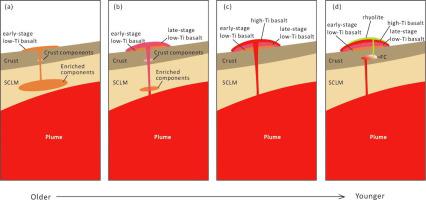Gondwana Research ( IF 6.1 ) Pub Date : 2021-10-18 , DOI: 10.1016/j.gr.2021.09.023 Hu Huang 1 , Peter A. Cawood 2 , Ming-Cai Hou 1 , Fu-Hao Xiong 3 , Shi-Jun Ni 3 , Min Deng 4 , Han-Ting Zhong 1 , Chen-Chen Yang 1

|
The late Permian to Early Triassic volcano-sedimentary succession associated with the Emeishan Large Igneous Province (LIP) is well preserved in the Binchuan area, Southwest China. This paper presents coupled zircon U-Pb age, trace element, and Hf isotope analyses from the succession, together with whole-rock geochemical compositions, to reveal the origin and evolution of volcanic rocks of the LIP. Zircons from the matrix and a rhyolite clast in the Lower Triassic conglomerate bed yield identical U-Pb ages of ca. 260 Ma and have geochemical affinities to those crystallized from within-plate magmas. These features, combined with the dominance of rhyolite clasts from this horizon, imply a source related to Emeishan silicic volcanic rocks. Zircons from silicic ignimbrite and rhyolite in the upper volcanic succession of the LIP display high εHf(t) values (+4.2 to +12.9), low Th/Nb and U/Yb ratios, and similar εNd(t) values (-0.17 to +0.47) to high-Ti basalts. These chemical and isotopic characteristics are consistent with the eroded silicic volcanic rocks, indicating that the late-stage silicic volcanic rocks were generated by fractionation of high-Ti basaltic magmas without significant crustal contamination. Although the late Permian zircons from the lower and upper low-Ti basalt successions all show arc-like geochemical characteristics with high Th/Nb and U/Yb ratios, the former has much lower εHf(t) values (-11.7 to -3.6) than the latter (+4.4 to +11.6), and the zircons from the upper low-Ti basalt succession show positive εHf(t) values similar to the studied rhyolites. Samples from the lower low-Ti basalt succession have relatively higher εNd(t) values (-2.66 to +3.38) than those from the upper low-Ti basalt succession (-4.48 to -0.82). These geochemical features indicate the early-stage low-Ti basalts may be mainly derived from a previously enriched subcontinental mantle lithosphere, whereas the late-stage low-Ti basalts may be generated from the increasing involvement of asthenospheric mantle source with crustal contamination.


























 京公网安备 11010802027423号
京公网安备 11010802027423号